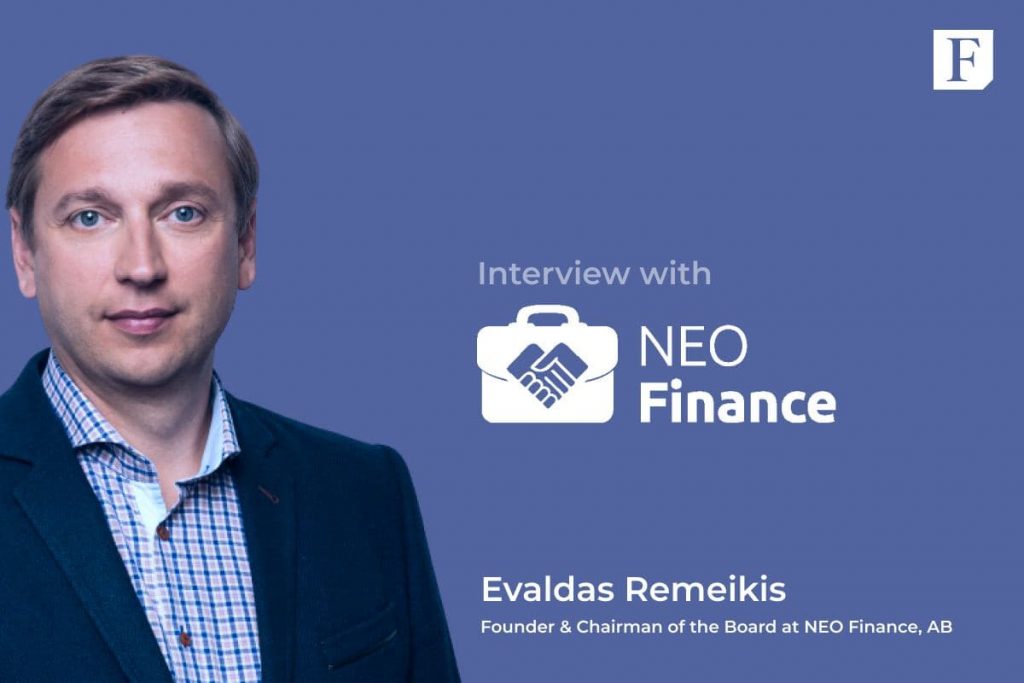In a recent interview with Finbold, Evaldas Remeikis, the founder and Chairman of the Board of the peer-to-peer (P2P) lending platform NEO Finance talked about the current state of the relationship between P2P platforms and traditional banks in attracting new clients. Remeikis also highlighted the progress of P2P platforms to the point of competing with banks.
Through personal experience, he also talked about the impact of the coronavirus pandemic on the P2P sector while sharing how different classes of investors reacted to the health crisis. Mr. Evaldas also detailed measures put in place by the Lithuanian headquartered platform to improve risk assessment capabilities. Finally, he gave the future outlook of the P2P sector and notable trends to look out for.
There is a constant growth of new investment tools and platforms. Do you think Peer-to-Peer (P2P) lending (investing in loans) is still attractive for the investors? Why?
“In my opinion, loans in the P2P sector will continue to grow. Investors in Lithuania and Europe are still discovering that this is an attractive method of investing. The rate of investments by people in some countries is currently less than 1%, however, the number of investors in the UK already constitutes a very significant share, and in Lithuania there are already more people investing in P2P platforms than in securities on the stock exchange.
Picks for you
If we examine the business model more deeply, we will see that this model is superior to the bank consumer credit model, especially when it is regulated as in Lithuania and the UK, so it is certain to gain a significant share of the bank consumer credit market. The key advantages are that the activities of these platforms remain highly focused and do not require any interest to be paid on deposits, which results in zero costs and less maintenance or bureaucracy.
Human loans do not pose the same risk as corporate loans that involve a risk of bankruptcy. Therefore, investing in personal loans has very low volatility, while the investors can still enjoy a good risk-return ratio. Although the returns are gradually declining due to lower interest rates, an investor can still earn a double-digit return. Moreover, the declining interest rates are attracting more risk-averse customers to the platforms that allow them to refinance large banks’ consumer loans.
We should expect to continue seeing a growing number of investors until the annual returns reach 4-5%, as investors continue to “migrate” to platforms where the return-to-risk ratio is best, and the NEO Finance platform has really great potential in this regard. This has been achieved by ensuring the security of our investments; for example, NEO Finance, AB has an electronic money license. Regulations also play a very important role in the willingness of people to invest in a platform, so we are glad that Lithuania is at the forefront of European countries where mutual lending is regulated.”
From your experience, what opportunities has the pandemic brought out for the P2P sector? Have you recorded growth or decline in new investor registrations in 2020 compared to 2019?
“First of all, it should be noted that the most loyal investors have been able to shop very profitably in the secondary market, while less experienced investors started panicking and selling off their investments into loans.
In terms of the number of investor registrations, the annual result was virtually identical: in 2020, there were 8,784 registrations; while in 2019, the number of registrations stood at 8,959. However, it should be noted that the cost of attracting investors was significantly lower in 2020, so we were able to attract more investors with the same budget.
Considering the uncertainty surrounding the Covid-19 situation, I would say that the fact that investors still trust the P2P platform is a good result. There was a particularly high increase in the number of investors in the second half of 2020. Without a doubt, this resulted in a great opportunity for the platform to increase its share of the Lithuanian consumer credit market, which is what we are successfully doing at the present time.”
You originally opened the business in Lithuania but expanded. Now, all EU citizens can invest in loans and earn interest on your platform. So far, what are the top three most active countries investing in loans?
“Of course, Lithuanians are the leaders in this field, followed by the Netherlands, Germany and Belgium. One reason why investors from Netherlands and Belgium make it into the TOP 3 is the attention we have paid to attracting investors from these countries. In addition, we have a subsidiary in the Netherlands that is responsible for attracting new investors from Benelux countries.”
The market has seen an increase in P2P lending and crowdfunding platforms over the last few years. What’s your take on this trend where the P2P sector is becoming oversaturated?
“Naturally, there is competition in the economy as, in addition to trying to capture a general market share, various niche projects are emerging in specific areas of financing, such as solar power plants financing. Therefore, the emergence of new platforms results in the emergence of financing niches. Of course, one day the market will become saturated, but this is unlikely to happen in Lithuania in the next few years because the platforms are growing at the expense of the competition by offering more value to borrowers and finding smarter solutions.
Nonetheless, in a few years, the market will become cramped and we may expect either withdrawals or acquisitions from certain consumer lending players (not P2P players) while the P2P platforms will acquire players smaller than themselves in terms of the lending volume. However, the negative aspects of the increasing number of platforms should also be mentioned.
There are always people who are seeking to make a profit at the expense of others. This results in so-called “scams”. We are therefore working hard to educate the market about regulated platforms and we aim to become the most secure P2P platform in Europe. We are actively pursuing this route and I think we have everything it takes.”
What type of investors does Peer-to-Peer lending appeal to the most?
“I would single out three main types of investors:
- First, there are the complete beginners, for whom a P2P platform is the first step in investing. It’s a lot of fun for these people, because our investments are relatively complex but, at the same time, the process is very uncomplicated. The participants do not require an understanding of fundamental or technical analysis; however, the platform itself can be quite challenging for newbies if they want to gain a deep understanding of how things work. New investments can be very attractive, because the investor can earn a reasonable high return without over analyzing things, so they can take their first steps without the fear of losing a share of the amount they have invested due to lack of knowledge.
- The second category is professional investors, who use the P2P option to diversify their portfolio. Often, these P2Ps don’t hold high asset value, but they will continue to exist as long as the investors are satisfied with the risk-return ratio, and their volume will increase. When the investor is no longer satisfied with the return or finds something better, they simply discontinue the investment.
- Finally, the third category is P2P fanatics. These are people who often have respectable jobs and are not necessarily financiers or economists, but who have some money they would like to employ profitably with as little risk as possible. P2P platforms are the perfect solution. In addition to the low level of risk, we ensure a stable positive return that is often significantly higher than is gained from investments with a similar risk. It should also be noted that young parents often use these platforms to accumulate funds for their children until they reach the age of 18.”
P2P platforms continue to lend money despite uncertainty regarding the repayment levels. How does NEO Finance manage the credit risk for borrowers?
“We have now been operating for over 5 years. Throughout this period, we have focused on improving our risk assessment capabilities. For more than a year, our platform has issued loans based on credit risk assessments performed using Artificial Intelligence (AI) algorithms.
This means that the AI absorbs all the data from the customer’s past and reaches a conclusion by evaluating more than 40 different parameters relating to the borrower. This practice has paid off as our borrower risks have become very predictable. Obviously, the AI algorithm cannot predict future economic events, so we expect that our return on investment will decrease during these turbulent times of the pandemic. But so far, we have not seen that decline occurring in 2020.
Furthermore, even if the return on investments falls by a few percent, we would still see it as an astonishing good result, because it sounds “too good to be true” in 2020. In the future, we will strive to improve the AI algorithm adding more and more criteria for it to analyse. For example, thanks to the PSD 2 directive (Payment Services Directive 2; an EU directive designed to produce safer and more innovative payments services), we will soon be able to obtain a client’s bank statement automatically (with his consent) and process the related statement data. The AI algorithm will then be able to evaluate a larger array of pre-processed data, further clarifying the borrower’s risk level.”
Do you consider banks as partners or competitors considering that they racked €12 billion in fines from regulators in 2020 alone?
“P2P platforms are now actively competing for borrowers with banks and balance sheet lenders. We are able to offer attractive terms to the customers of both banks and other lenders, and although we have heard the story that P2P platforms are only useful for customers who do not qualify for bank loans, we can say this is definitely not true. Those times are long over – in fact, I would say this stage ended in 2017. Since that time, the platforms have grown, became stronger and now have a powerful money supply thanks to the large number of investors.
In addition, more and more bank customers are comparing the conditions found in our NEO Finance platform with the traditional options, and bank loan refinancing is growing quite rapidly. For the purpose of comparison, in the 4th quarter of 2020 we refinanced consumer credit loans issued by banks that were worth € 604 thousand; while in the same quarter of 2020 we refinanced loans amounting to € 338 thousand, i.e. 78% more in a single year.
This ongoing trend will increase the pressure on banks and they will have to react. A bank manager’s traditional reaction cycle to Fintech goes something like this:
- contempt (they will go bankrupt);
- it’s is a small niche player that poses no threat to us;
- they are only doing well because they don’t follow the regulations; and finally,
- too late to react (they have outmatched us, as our decisions were made too late).
However, I must admit that the banks are increasingly realising the potential of Fintech companies nowadays, and there are many who want to become partners. In the future, the banks will either be forced to invest in such platforms or these platforms will expand to acquire uncompetitive banks.
It’s only a matter of time before the banks will be able to acquire stakes in Fintech, and after a few more years, they will be forced to look for survival solutions in such lending activities like consumer loans. I wouldn’t attach much importance to fines, as they pose no threat to the banks’ survival, but instead divert the management’s attention away from lending activities by focusing on compliance, which only benefits the P2P platforms.”
What are the top three main advantages of P2P lending every investor should know?
“A loan involving a natural person is a real investment in that person’s ability to earn a good income – the loan must be repaid, but there is no fixed deadline. The result is a simple tool that does not require a large financial or economic analysis. Instead, the required knowledge and risks are assessed, which often leads to a great return that exceeds the return on other investment instruments.”
How will the P2P marketplace evolve in the next few years? As a leading industry player, what will be your projection?
“It’s very hard to tell what the future holds. We may see an emergence of banks or other institutional investors who have recognised the trend for developing platforms and decide to become partners, to lend their capital through the platform while acquiring a significant stake in the process.
Acquisitions may also occur where the platforms purchase other consumer credit providers or obtain their portfolios. However, it is possible that this will not happen, and the platforms will instead start their own geographical development when the operational market becomes saturated so that continuing to increase their market share becomes more expensive than expanding to another country.
New platforms may continue to emerge, in which case the number of mergers may rise. What is clear is that we will soon witness one of the above mentioned scenarios. All the market players want to grow, and P2P platforms are no exception, so only time will reveal which ones will become the most successful.”
End of the interview.







